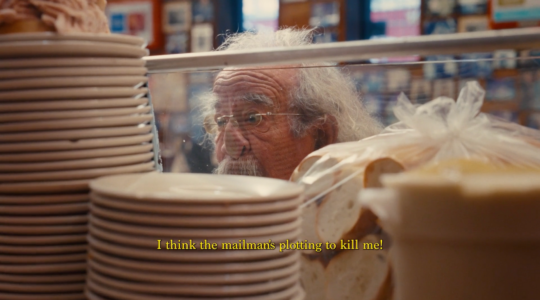The 1970s was the age of heroic avant-gardism, a period of out-sized works — the lengthy “operas” of Robert Wilson, the monumental portraits of Chuck Close, Thomas Pynchon’s “Gravity’s Rainbow,” William Gaddis’ “J.R.” It was a time of omnivorous works that strove to include the entire world — self-referential, bombastic, difficult endurance tests fueled by a frequently thrilling blend of audacity, encyclopedic knowledge and testosterone — nowhere more so than in film, and nowhere in film more than in the films of Hans-Jurgen Syberberg.
Syberberg made seven films in the 1970s, and their combined running time is a hefty 1,365 minutes. His last three films of the decade account for 931 minutes: “Karl May” (1974; 187 minutes), “Winifred Wagner und die Geschichte des Hauses Wahnfried von 1914-1975” (1975; 302 minutes) and the obsessive, hallucinatory “Hitler: A Film from Germany” (1977; 442 minutes). This week Anthology Film Archives will be showing “Karl May” and “Hitler” along with the filmmaker’s slightly more modest “Ludwig: Requiem for a Virgin King,” a brilliant, maddening, unwieldy trilogy in which Syberberg gropes for something called the German character.
In that respect, Syberberg was a bit of a throwback, a filmmaker who like Thomas Mann believes in an old-fashioned notion of national character. Syberberg’s idea of what that might mean for German culture, particularly German Romanticism, is deeply jaundiced. As he makes abundantly clear through the seven hours of “Hitler,” Syberberg sees the Nazi leader as the embodiment of something fundamental to German culture and the German people. Hitler is everything that the Germans dared not speak aloud about themselves.
Syberberg’s filmmaking technique is deliberately primitive. The film has no sets to speak of, mostly projected backdrops. He uses almost all the footage he shoots. It is no accident that one of the chief recurring images in the film is a reproduction of the Black Maria, Thomas Edison’s film studio, one of the first real film stages in history. Syberberg’s faith in the power of the film medium is almost charming in its naivety. The film’s title is not chosen casually: “Hitler, ein Film aus Deutschland.” Hitler himself is a film, a production of Germany as a huge dream-making machine. And the dream, like so many of the great German silent films, is an expressionist nightmare.
Hitler is certainly the “movie” at the heart of Syberberg’s work (and not only of this film, of course). We see him as a giant puppet, as a specter in Roman toga rising from the grave of Richard Wagner, as Charlie Chaplin. We see him through the eyes of his valet and we hear his speeches and those of his underlings repeatedly on the soundtrack.
At the same time, though, “Hitler” is a film about film history. Film, Syberberg proclaims is the art form of the 20th century. Although his film draws on other art forms compulsively, from the etchings of David and Dürer to the music of Wagner and Strauss, “Hitler” is as much about film and its impact as it is about Nazism. (Given that the Nazis themselves were obsessed with documenting their reign on film, this is not as odd an idea as it first might seem.)
Syberberg anchors his film’s desultory structure with the above-mentioned recurring images of Black Maria, even enclosing it in a snow globe, an obvious reference to “Citizen Kane.” We see Hitler parodying Chaplin’s dance with the globe from “The Great Dictator,” we are reminded of the ways in which Hollywood wrecked the works of great filmmakers like Erich von Stroheim (perhaps not coincidentally, a German Jew) and, in one of the film’s most startlingly effective juxtapositions, we see Peter Kern (a Fassbinder regular) in an SS uniform, re-enacting Peter Lorre’s speech as the child murderer in “M,” giving a new, more ominous spin to his cry, “I can’t help it.”
But love of cinema is also where the film founders. Of course the destruction of von Stroheim’s “Greed” was a cultural crime. But von Stroheim was not only allowed to keep working, he went back to MGM, the studio that had shredded his masterpiece. Irving Thalberg didn’t have him killed. And when Syberberg argues that the film cultures of both West and East Germany are as aesthetically vapid and morally bankrupt as that of Nazi Germany, he’s ranting.
As one might expect, “Hitler” is too complex, too daunting a work to be absorbed in a single viewing. The film is wildly uneven but seldom dull, and it has moments of astonishing power. While one may disagree with Syberberg’s reading of German culture, and the primacy he grants it in the larger scheme of Germany history, there is no gainsaying his antipathy to the forces that brought the Nazis to power or to their racial policies. When Syberberg’s Hitler says of the German people of 1977, “I was and am the end of your most secret wishes,” it’s hard to disagree.
“Hitler: A Film From Germany” will be shown at Anthology Film Archives (Second Avenue and Second Street) on Saturday, Sept. 11 at 2 p.m. and Sunday, Sept. 12 at 2 p.m., as part of a program of Syberberg’s films that runs from Sept. 9-14. For information, call (212) 505-5181 or go to http://anthologyfilmarchives.org.
The New York Jewish Week brings you the stories behind the headlines, keeping you connected to Jewish life in New York. Help sustain the reporting you trust by donating today.




